
woodburner
-
Posts
901 -
Joined
-
Last visited
Content Type
Profiles
Forums
Store
Help Articles
Posts posted by woodburner
-
-
The more I research and look at induction cooktops I get just a bit gittier. What is there not to like about them?
woodburner
-
Can anyone point me to a method to figure out how many cubic feet of gas or kilowatts of electricity would be used for an hour of 350 or 450 degree cooking for a particular model/brand name of range?
I doubt you'll find exact figures for any or all ranges and ovens, but here from the California Energy Commission, is a breakdown of oven operating costs, by fuel type.
Plug in your own local gas therm and electric Kwh costs for a more accurate assertation.
woodburner
-
A really good spot for bistro dining, just north of Hudson, located in Chatham is the
I live and work in the area, and the Blue Plate gets high grades from locals and weekenders. Pretty sure they offer Jazz on Wednesday nights. The lamb is about as good as it gets, being raised locally at the Chatham Sheepherding Company, along with the cheeses.
woodburner
-
Just had an excellent meal tonight at a new restaurant in Saratoga, The Mouzon House located on 1 York street near the Farmers' Market (518-226-0014). This restaurant as well as One Caroline Street is run by David and Dianne Pedinotti. david is the chef at Mouzon.
The price for two including cocktails, food, wine and tax prior to tip was $152.50.
This restaurant is a very welcome addition to the Saratoga restaurant scene. It has plenty of character, class and excellent food. I will happily return.
This meal was had anonymously and no comps were received.

Reviewed in the Times Union, Restaurant Review section today.
woodburner
-
Started my research for a new Electric Range today. I'm considering Bosch, Maytag and the likes.
Found some interesting information regarding warranties.
Effective January 1 2006, most all major market players of residential equipment will be slipping the warranty from 3 years to 1 year on parts.
Oh yeah, price hikes on most will go into effect the same day.

I was hoping for a price break after the holidays.
woodburner
-
Rinse very well after brining, or set the turkey or fowl into plain water and change out twice, after about 20 minutes each.
Woodburner, this was excellent advice, thanks! I've had problems in the past with over-salty turkey and too-salty drippings, but your idea of 2 20-minute soaks solved the problem of over-saltiness. The bird was very juicy and not salty.
I also find that brining additives like herbs (esp. bay & rosemary) and garlic do flavor the meat; I boil them with the salt & sugar for 20 minutes, then dilute with cold water to the right proportion. I use 1 C kosher salt + 1/2 C sugar per gallon. (BTW, I put the small-leaf herbs like thyme & rosemary in a cheesecloth to keep them from sticking all over the bird's skin.)
Glad it helped, Jay.
woodburner
-
The USDA currently limits the total fat content of fresh sausage to 50 percent, which is pretty freakin high in most people's world including mine.
Ground beef is graded to lean/fat content, ie: 80/20 for ground chuck.
What is puzzling, to me at least, is that there is no current limit to the fat content in store bought ground pork. I don't expect nor do I want, the federalies to watch over me, don't get me wrong, but what would be so radically wrong with listing the fat content on ground pork packages?
Or better yet, how can I test for the fat content, in my home?
woodburner
-
-
I'd agree with your butcher and I've made some good fresh sausages at home for a piker, using just pork butts with no added fat. I've read but could not substantiate with any valid source that butts contain about 20 per cent fat.
Cured sausages would be a different thing, and many types would require more fat than the butt alone.
Through the past 5 years or so I've tried differnet formulations from different butcher shops and artisian sausage makers who have offered thier own ground pork being sold by the pound, most who usually make and sell fresh sausages.
My conclusion which I can't substantiate here without the use of digital images, is that many if not all formulations purchased from sausage makers had a visual difference of having a higher fat concetration than whole butts which I have ground at home. How much, maybe 10 percent more by volume.
So I would conclude you can use whole butts only, but there is a benifit too adding maybe a bit more.
Sausage making is a big new wonderful world
woodburner
-
I'll second the Guido's blurb. Both locations Great Barrington and Pittsfield.
Also have heard a few good words regarding The Meat House from a few friends. Any comments regarding them?
woodburner
-
With all due respect
Please point me to any Carolina bbq place that brines any pork for bbq.
thanks
woodburner
-
lcdm
The confusion lies with temperature at the cooking level, I think as you suggest.
I would caution with not filling the water pan with water and letting the fat drip into the dry pan, this could turn into disaster if the pan in a WSM erupts and it will, with a pan full of grease directly above a heat source.
You can easily cook with out the water pan, and let the fat drip into the heat source, and at the same time maintain 250ºf cooking temperatures.
woodburner
-
Hi Neal,
Temperature should be measured at grate level, your using a probe thermometer so make sure prior to your cook, that it's properly calibrated. Put the probe in ice water and see if the digital reading is 32ºf, and then put the probe into boiling water and make sure it registers 212ºf or close to. If it's way off in either direction get a new one.
A quick and easy way to measure at grate level, is to stick the probe, fully through a potato and put the potato on the grate close to the Turkey. By doing this you will keep the probe off of the metal grate, which could possibly give you a false reading.
I hate making predictions to how long it will take someone to smoke cook anything, but I would ballpark a 12lb turkey for about 6-7 hours cooked at 230ºf.
Brining may speed the cooking process up just a bit, and the other big item is what temperature is the turkey, when you put it on the cooker.
Monitor the internal temperature of the turkey and shoot for 175ºf in the thigh.
Of course all my above advice is cooking the turkey whole.
If at some point you feel your in trouble and it's not getting done, I would remove the turkey from the pit and chop it in half, and then put it back in to cook.
I hope I've helped some.
Remember, before you start: mise in place
Allow yourself plenty of time.
woodburner
-
From the "Independent News and Media (UK)
Entropy, Dover Street, Leicester
"Cockerill has cooked at some fine establishments including the Vineyard at Stockcross and Hambleton Hall, as well as doing a stint at Heston Blumenthal's Fat Duck. Like Blumenthal, he does much of his cooking "sous vide" in vacuum-sealed bags and, like Blumenthal, he uses a scientific water-bath capable of maintaining pre-set temperatures, accurate to a tenth of a degree".
woodburner
-
Is DQ curing salt similar to Morton's Tender Quick?
woodburner
-
Headed for a smoke bath in the morning. Among the two 8lb butts, are a brisket flat and a few racks of beef ribs, plus a few chicken halves.
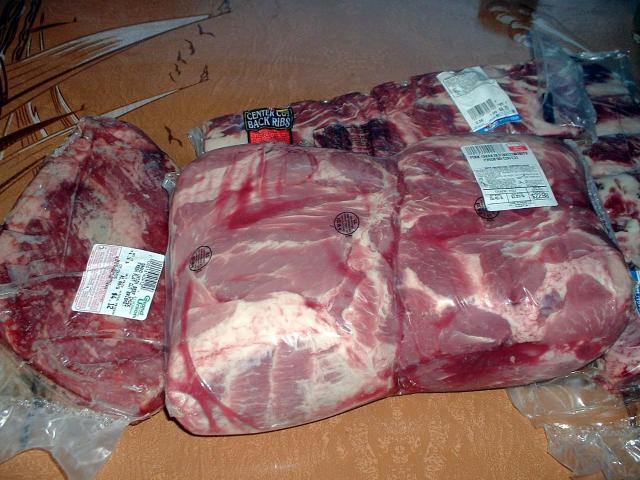
I'm a Chris Lilly pork injection covert, apple cider, water, brown sugar, and wooster sauce.
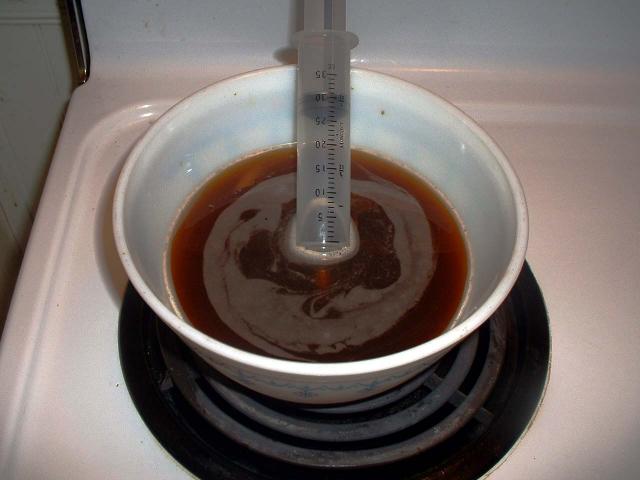
There is some leakage, but for the most part it stays inside the pork.
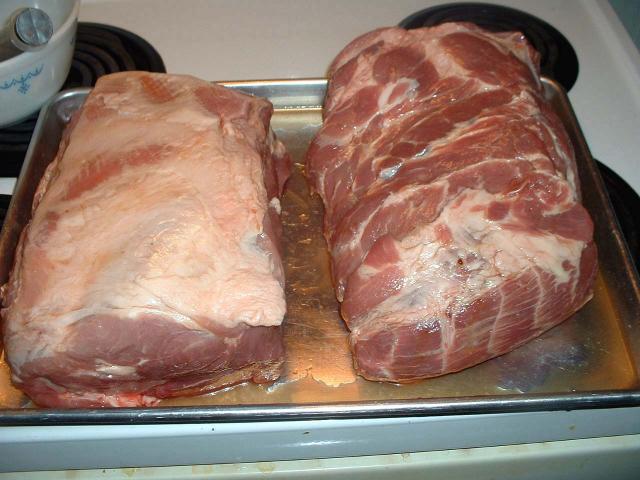
wish me luck.
woodburner
-
Samascott Orchards is nestled inside the Village of Kinderhook, about 3/4 mile from my house. They do bake all of their pastries and pies on site, at their apple barn right here in the village.
They are very well supported here in the upper Hudson Valley, and very nice to see you supporting them also.
Very hard working fruit and vegetable farm family by the way, and well respected I might add.
very nice blog
woodburner
-
Oyster dressing,
 my fave. (I've only used fresh but canned should work)
my fave. (I've only used fresh but canned should work)Sausage stuffing and Cornbread stuffing.
Thanksgiving at my house this year

welcome Roxie.
woodburner
-
I'm also a brine convert, but there are some, who report that the bird tastes too salty even after confirming salt amounts, such as you have just done. I recall reading that Harold McGee, feels brining leaves too much salt flavor for his own personal taste.
For you and your guests sake, I would suggest brining a small chicken and then roasting, before moving on to a turkey.
Here are a few, of my personal observations over the years, in no particuliar order.
There are two common brands of Kosher salt, Morton and Diamond.
Morton Coarse Kosher Salt weighs 8.1 oz. per cup
Diamond Crystal Kosher Salt weighs 5 oz. per cup.
I prefer too boil the water after the salt is added just to ensure dillution, then allow to cool before sending the turkey for a swim.

I also use brown sugar.
Brined poultry will cook a bit quicker than non-brined, not alot, but some.
I brine 24 hours for turkey and 12 for whole chickens.
I have to disagree on the additions of flavors in the brine. I incorporate maple powder into the brine, and I can get the flavor into the turkey.
Rinse very well after brining, or set the turkey or fowl into plain water and change out twice, after about 20 minutes each.
Air drying works well, but I find if time or space does not permit it, I just adust the oven knob a bit upwards, towards the end of cooking.
My last tip, and I really laugh every time I do it, is rub the entire outside of the bird in every last nook and cranny with Kitchen Bouquet.
Enjoy
woodburner
-
This sounds very tempting to me, but I'm having trouble producing a visual in my mind regarding incisions around the bone and packing with salt part. Hopefully someone will post a few images for us to see how it's done.
In the mean time, I've done just a bit of poking around, and found this article
Hog killing, Salting down the meat
I've heard of folks "dry packing" meat, but in our part of the world, everybody used a wet packing process. That is, we packed the meat in dry salt, but we always prepared a barrel full of liquid pickle to pour in the vat or barrel immediately after packing the meat. The pickling solution was simply water mixed with enough salt that a hen egg would float on it. Put an egg in water and see if it floats. Nope, it won't. But add enough salt and it will.
A twenty pound fresh ham, as the original recipe suggests would be difficult for me to procure. Somthing a bit smaller will be easy for me to find, so I'm going to take a shot at the wet cure method, for documentation purposes only.
woodburner
-
Chuck roast also has a hidden secret which some people are unaware of. Slow roasting in a 225ºf oven for about 6 hours until the internal temperature reaches 170ºf or a sharp fork slides right through.
It will stall in internal temperature for about an hour or so at 160ºf, very similiar to brisket, just let it cook. When done the meat will shred perfectly for beef taco's.
woodburner
-
Beef Chuck roast, is a great cut for slow simmer with vegetables, plus they work well reheated, and they are inexpensive as far a current beef prices go.
You also might look at joining a wholesale club like BJ's or Sam's. You can purchase large size beef cuts, and cut them down to your liking.
woodburner
-
For further clarity, salt addtions should equal 3 Tbs of pickling (non-iodized) salt, per 5lbs of shredded cabbage in volume, or between 2 1/4 -2 1/2 per cent of weight.
In search of alternative methods to canning the fermented cabbage I've pretty much come to the conclusion that I'll store my portion fresh here in my cellar, in a air tight covered crock. I've not been overly happy with the kraut which we have normally set up in canning jars and further processed.
Canning tends to turn the sauerkraut a brownish tint, and takes away the important crunch in the bite.
woodburner
-
We start out with two different sources of cabbage heads, both from Canada. While not exactly sure of the boxed heads, which contain 12 each and the 50lb bags, which are marked in French, each bag contains twelve head.

We use a wooden style mandolin which contains recently sharpened blades to do the shredding whilst the small wooden box is slid back and forth to slice the cabbage in three layers.
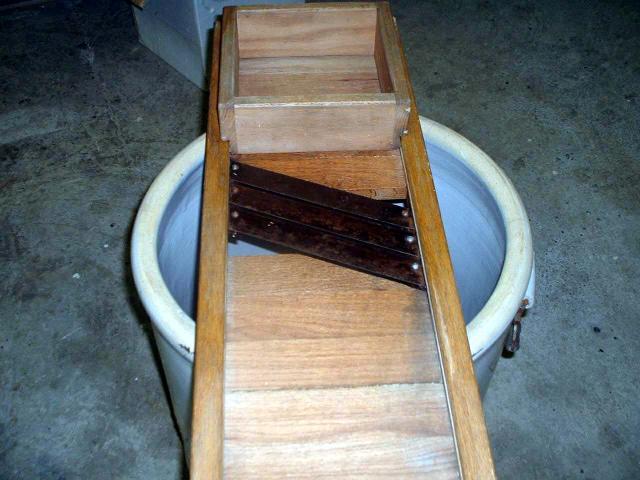
The heads are cored and quartered for the proper size shredding.

Gentle tamping during salt addtions to pack the cabbage, and to initiate the brine.
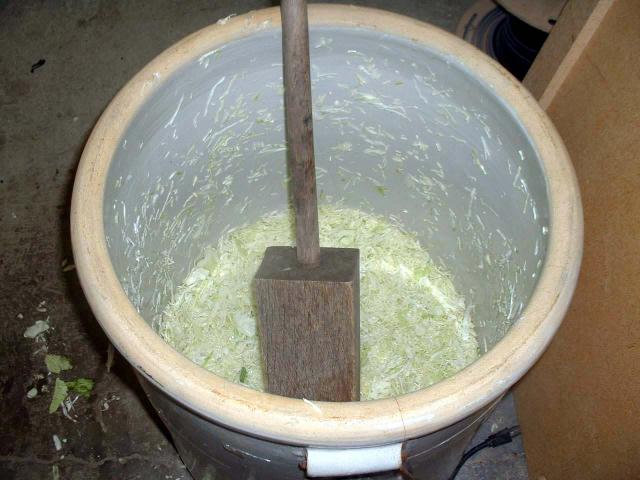
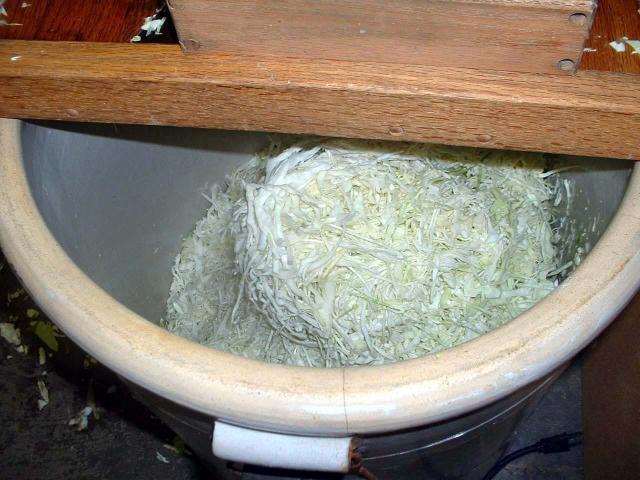

While somewhat hard to see, the larger halved head in the center of the image, shows a head that was taken from the plastic bag lot. It clearly shows a more dense cabbage than the boxed heads, but proved to have much less flavor, which was very intresting.
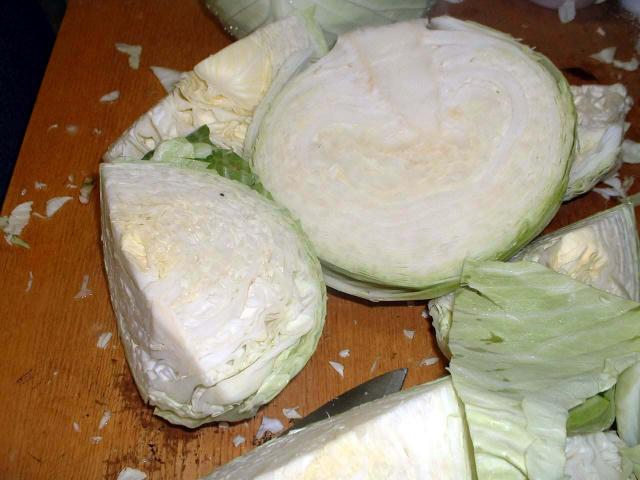
This image shows a full crock of shredded cabbage with water starting to weep about 2 inches from the top of the crock.

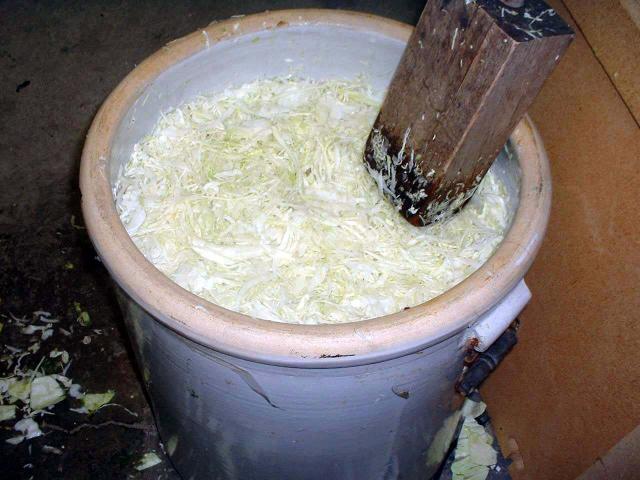
We will skim any scum that forms for the next few weeks, and then onto the canning process after that.
woodburner

Joel Robuchon's Mashed Potatoes
in France: Cooking & Baking
Posted · Edited by woodburner (log)
I'm pretty well jacked up over this potato thread.
Seems like there is a line drawn in the sand, in potato variety between mashed, and puree.
So my question is this technique considered mashed, or pureed?
woodburner